A Guide to Some of the Oldest Churches in Israel
For many visitors to Israel, whatever their religious background, one of the highlights of the trip will be exploring the country’s many historical and religious sites. Israel has countless churches open to the public, many of them dating back hundreds of years, and as well as a great number in the capital, Jerusalem, there are some beautiful and fascinating buildings across the country. For Christians visiting Israel on a package tour, walking in the footsteps of Jesus is an incredibly moving experience, and the expedition of a lifetime. But you don’t have to be a Christian to find these sites extraordinary. Here, we look at ten of the most ancient churches in Israel and why tens of thousands of people each year flock to them, to gaze in awe at their architecture, mosaics, artefacts and let themselves be transported back in time…
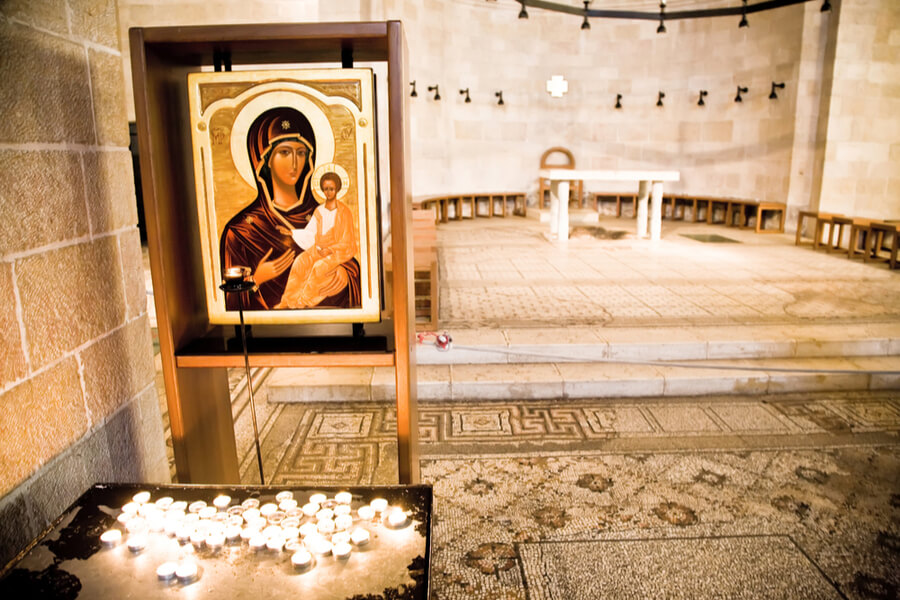
Church of Multiplication, Tabgha, Israel. Photo credit: © Shutterstock
1. Megiddo, Jezreel Valley
The Meggido church, in the Jezreel Valley, is located near Tel Megiddo in northern Israel and was found in a dramatic archaeological discovery in 2006. Its foundations date back to the 3rd century, making it Israel’s oldest church (even older than Jerusalem’s famous Church of the Holy Sepulchre). Astonishingly, it was found behind the doors of a maximum-security prison - indeed, some inmates helped archaeologists with the excavations!
Findings there included an elaborate, well-preserved mosaic, which is unusual in that there are no crosses there, rather a picture of two fish lying side by side. Historians say this is the sign of a very early symbol, dating back to the period before Christianity was officially recognized as a religion (i.e. before Saint Constantine’s rule). There is also the inscription on the mosaic which names a Roman army officer - Gaianus - who donated money to the building of the floor. Combined with a trip to Nazareth, a visit to Megiddo is well worth your time.
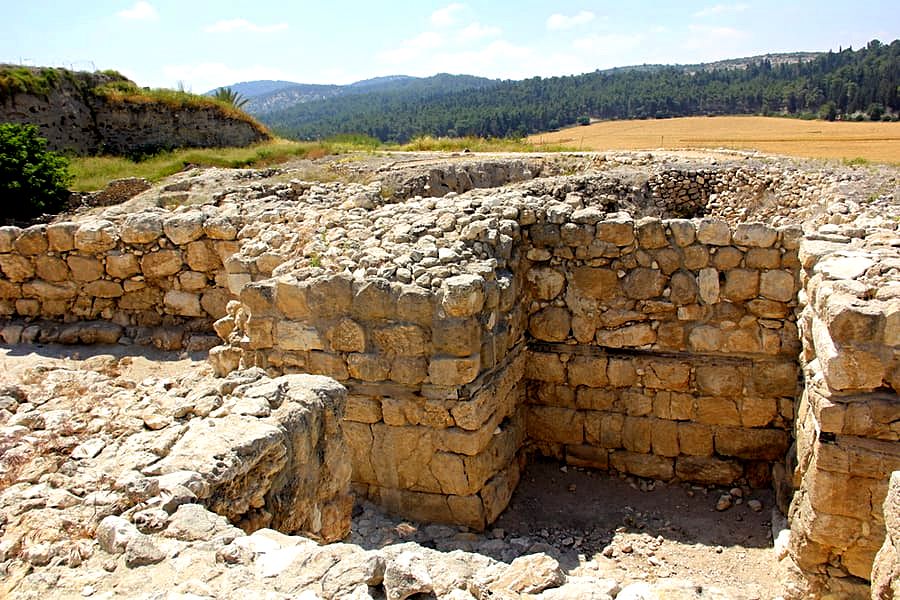
Tel Megiddo, Israel. Photo credit: © Shutterstock
2. Ein Avdat, Negev Desert
Situated in a canyon, in the heart of the Negev Desert, the southern church there was part of the Byzantine Monastery or St. Theodoros. According to inscriptions found on the church floor, historians estimate that the church dates back to the 6th or 7th century. Archaeological findings show that the Ein Avdat church was inhabited both by the Nabateans and Catholic Monks.
Historically, Avdat was a stop along the ‘Spice Route’ which transported spices and perfumes from the Arabian Peninsula to the port of Gaza. Because the area had many springs, a water supply was plentiful and the area quickly prospered. Little is left of the church today but we do know that reliquaries - containers holding a sacred relic - were kept inside. Once the oil had been poured over the relic, it was collected in bottles for pilgrims to keep as a souvenir.
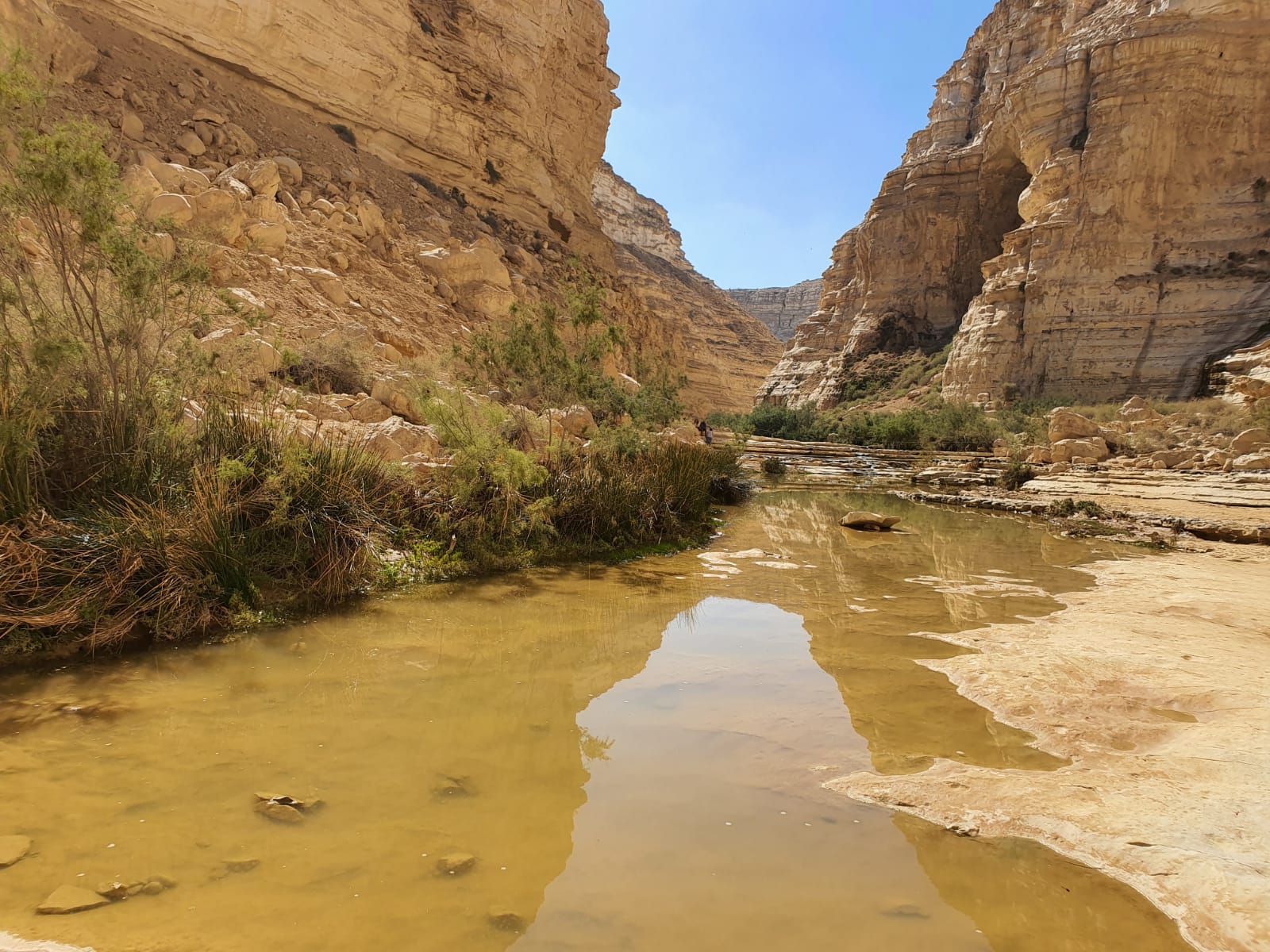
Ein Avdat, Israel. Photo credit: © Oksana Matz
3. Church of the Multiplication, Tabgha, Galilee
Much of Jesus’ ministry and preaching was carried out in the Galilee and this church - situated in Tabgha, on the northwest side of the lake, the Church of Multiplication is famous for being the spot where the miracle of the ‘two fishes and fives loaves’ were multiplied, in order to feed 5,000 people. This extremely old Byzantine church contains beautiful mosaics, depicting animals, plants - particularly the lotus flower - and geometric figures, all adding to its charm.
The church underwent excavation in the 1930s and a new building was inaugurated in May 1982, to commemorate the sacred space as well as to accommodate the thousands of visitors who wanted to visit each week. Today, it is one of the most popular places to visit for tourists traveling around Galilee and Nazareth, either on historical or Christian day tours. Fun fact; the church windows are not made of glass, rather of stone! For a moment of quiet reflection, visit the pool in the backyard, which is full of fish. Other churches in the area can be visited with a Christian galilee tour.
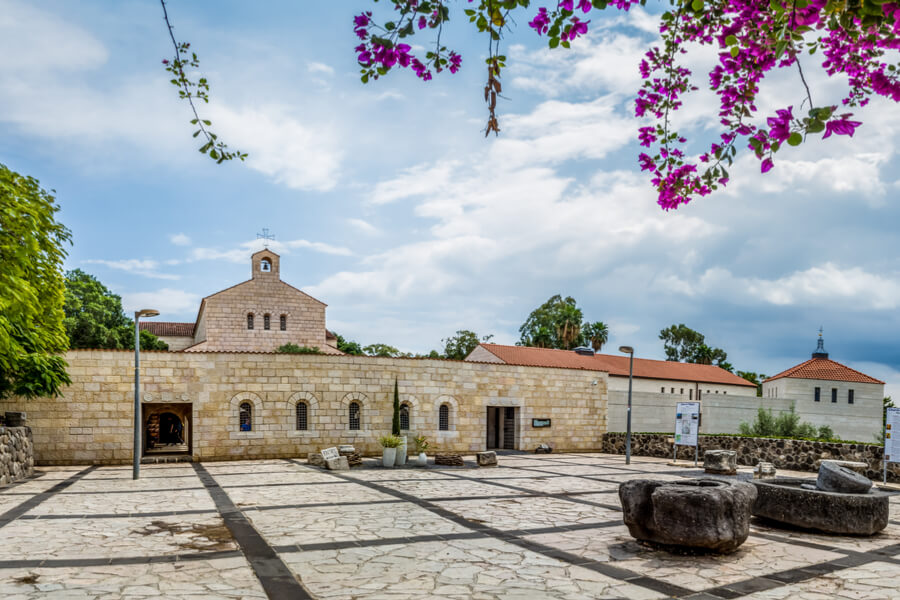
Church of Multiplication, Tabgha. Photo credit: © Shutterstock
4. Church of the Pater Noster, Jerusalem
Situated at the top of the Mount of Olives, the history of the Pater Noster dates back to the rule of Emperor Constantine, who erected a simple building on this site in 330 known as ‘Eleona’. ‘Pater Noster’ in Latin means ‘Our Father’ and according both to tradition and the Gospel of Luke, the cave forming the grotto (under the church) was where Jesus taught his disciples the Lord’s Prayer, which begins “Our Father, who art in heaven...”
In 1874, the present church (which is part of a Carmelite Monastery) was erected. This credo is represented on the walls of the church, in the form of the Lord’s Prayer translated into close to 130 languages, all painted on ceramic tiles. The gardens are well landscaped, full of olive trees, and this tends to be more peaceful and (generally) less crowded than others in Jerusalem. Ideal for a visit on a day tour of Jerusalem.
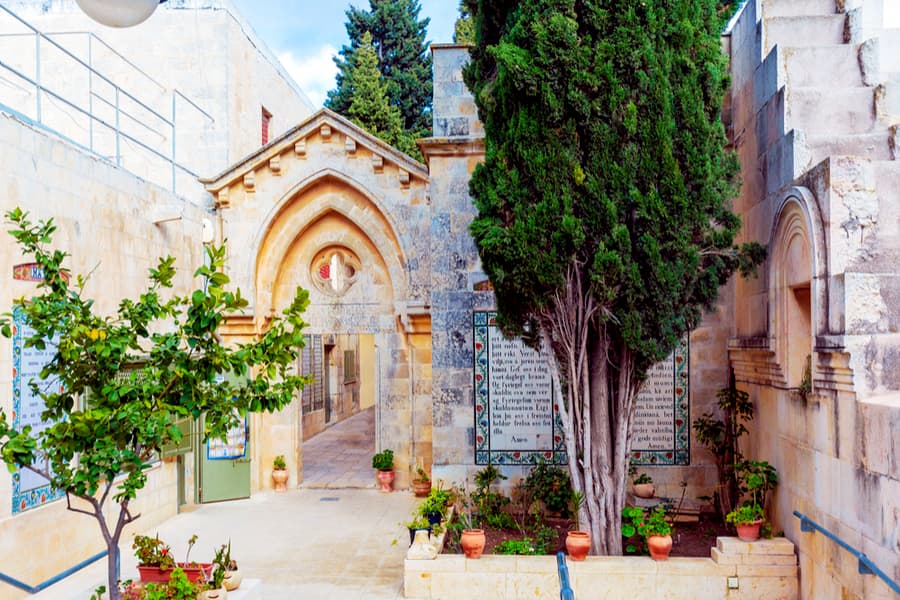
Pater Noster Church, Jerusalem. Photo credit: © Shutterstock
5. Church of the Nativity, Bethlehem
The Church of Nativity, a famous Bethlehem basilica, located just 10 kilometers from Jerusalem, is loaded with significance in that Christians believe it to be the birthplace of Christ. Built in the 6th century by Emperor Justinian, it replaced Constantine the Great’s original structure (dedicated in 339 CE), and today is the oldest complete church in the Christian world.
The interior of the church is somewhat minimalist (no pews in which to sit) but the wall mosaics - depicting saints and angels - are stunning and have been restored. The roof is held up by red limestone pillars (the stone obtained from local quarries). Two sets of stairs will let you descend to the Grotto of the Nativity where there you will see a 14-point silver star. This marks the exact spot of Jesus’ birth. This sacred spot is well worth a visit, perhaps by joining a Bethlehem half-day tour?
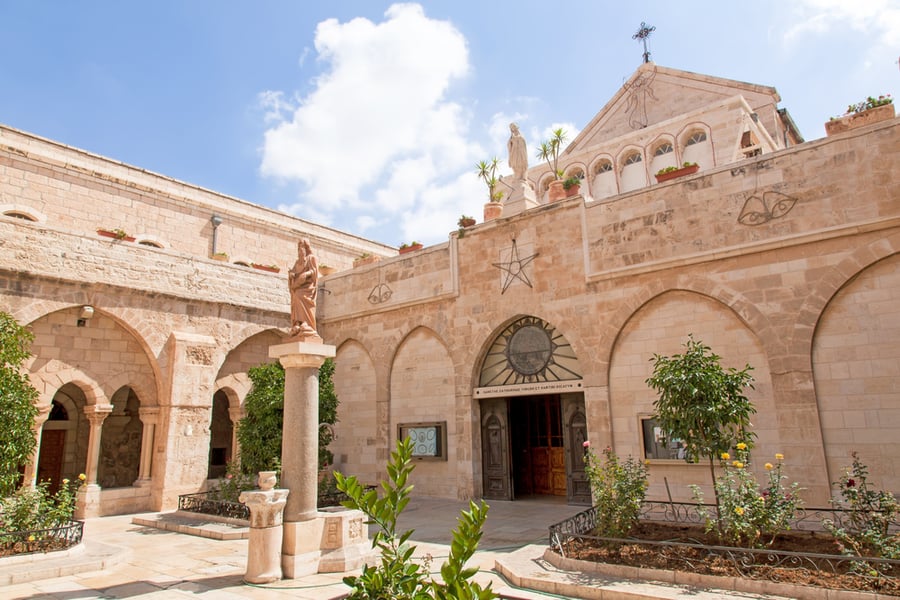
Church of Nativity, Bethlehem. Photo credit: © Shutterstock
6. Church of the Transfiguration, Mount Tabor
This church is located on Mount Tabor in Galilee and is recognized as the place where Jesus was transfigured in the presence of his disciples, Peter, John, and James (notated in the Gospels). Because of its location along the major trade routes, the area was always of strategic importance in wars. The entire surrounding area, including Tsipori and Beit Shearim, is well worth exploring on a private tour.
The Church of the Transfiguration is perched very dramatically atop the mount, offering visitors stunning views, and was built over the remains of previous churches from both Byzantine and Crusader times. The current building was erected in 924 by the Franciscans and boasts an impressive mosaic and chapels dedicated to Elijah and Moses. The smaller Greek Orthodox church nearby is not usually open to the public.
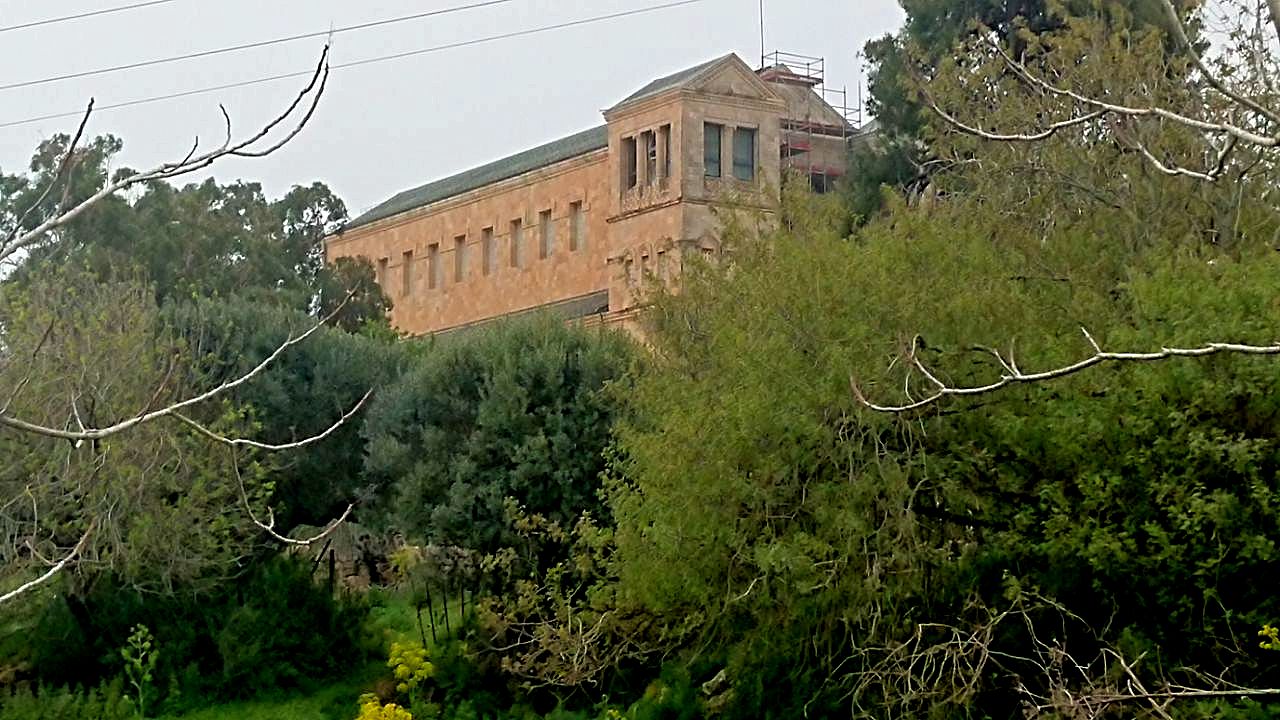
Church of the Transfiguration, Mount Tabor. Photo credit: © Natalia Brizeli
7. Church of the Ascension, Jerusalem
The beautiful Church of the Ascension, run under the auspices of Russian Orthodox nuns, is situated in Jerusalem, on the Mount of Olives. Dedicated to the ascension of Jesus (the day that Christ physically departed Earth, in the presence of 11 of his apostles) its tower - at 64 meters - was constructed at the end of the 19th century, so that pilgrims who could not walk as far as the Jordan River could at least climb its steps and take in the view. At the tower’s top is a belfry and inside it a heavy iron bell, the first-ever Christian bell to be rung in Ottoman times.
The original structure was built in the 4th century but most of its inside, today, dates back to Crusader times. On the floor inside is a slab of rock, with an imprint inside which is considered to be Jesus’ footprint. This is known as the ‘Ascension Rock.’ After Muslims took control of the chapel from the Crusaders in 1188, they converted it into a mosque - look carefully and you will see a minaret. The Mount of Olives has three other churches that are associated with the ascension, and an excellent way to see them is on a private walking tour of the area.
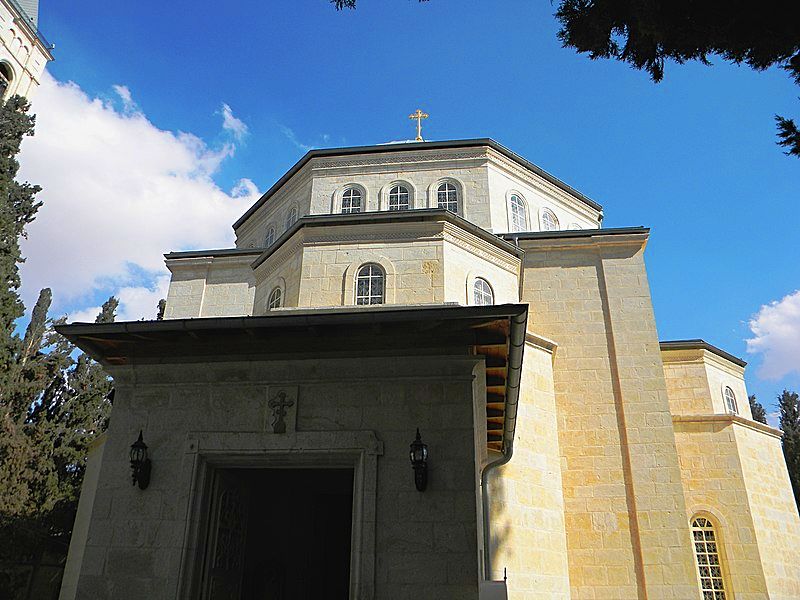
The Russian Orthodox Church of the Ascension, Jerusalem. Photo credit: © Dan Porges
8. Church of the Holy Sepulchre, Jerusalem
Without a doubt, the most famous church in Israel and a highlight of any visit to the capital, the Church of the Holy Sepulchre sits within the Christian Quarter of the Old City of Jerusalem. Famed for being the place not just at which Jesus was crucified but where he was also buried and resurrected, it is a focal point for Christian pilgrims, particularly at Easter when pilgrims retrace Christ’s last walk along the Via Dolorosa (the last four ‘Stations of the Cross’ are within this church).
Built by Constantine the Great in 326 CE over a tomb believed to be that of Jesus, it took nine more years before commemoration and the wooden doors of the church are original. Inside the magnificent interior are a number of sites including the tomb of Jesus (which sits under the largest dome in the church) the Anointing Stone (tradition says that this is the spot where Christ’s body was prepared for burial) and Calvary itself (which has two chapels, one of which houses the Rock of Golgotha, which can be seen through the glass.
The jurisdiction of the church compound is divided between the Catholic, Armenian, and Greek Orthodox Churches. (Interesting fact: look out for the thousands of crosses, scratched into the walls by Crusaders traveling to the Holy Land from Europe). Truly one of Jerusalem’s most breathtaking sites and a must-see on a tour of the Old and New City.
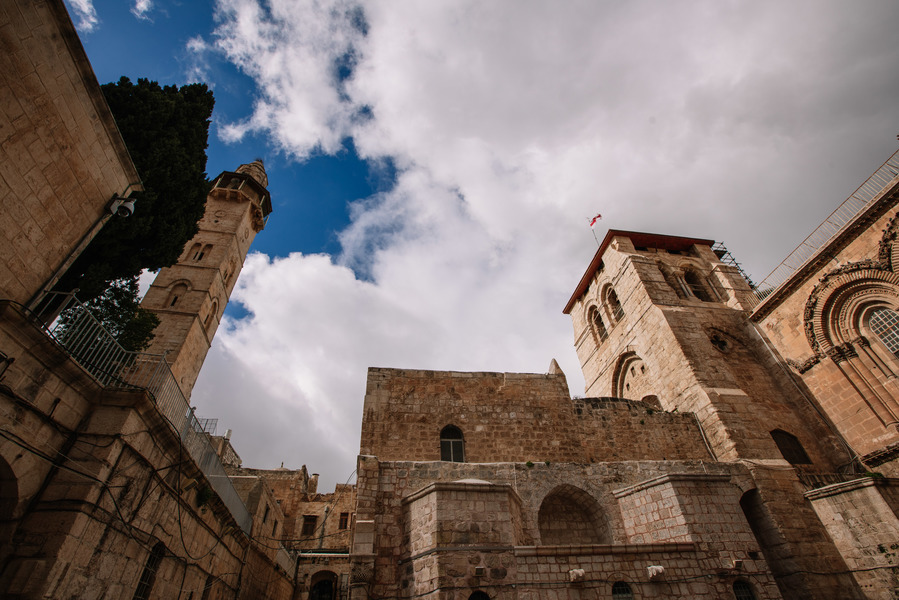
Church of the Holy Sepulchre. Photo credit: © Dmitry Mishin
9. St. George's Monastery, Wadi Qelt
St. George's Monastery, one of five monasteries in the Judean desert this extraordinary building has been carved into the edge of a cliff in the north-eastern part of a huge canyon in which it sits. To reach it, you walk down a somewhat steep but paved hill and across a bridge - the location is extraordinarily picturesque and impressive and even overshadows the monastery itself.
The monastery itself was settled in 420 CE, by Syrian monks, in the emptiness of the desert. It is, however, named after Saint George of Choziba, a Cypriot monk who lived there in the 6th century. Inside, the chapel remains in its original form. The monastery is multi-layered, with two churches, both of which contain icons and mosaics, and the doors in iconostasis date back to the 12th century. Following the stairs down from the courtyard, you will find the Cave of Elijah. It is possible to explore this monastery alone but not easy or particularly advisable because of its remote location so probably best to take a private guided tour.
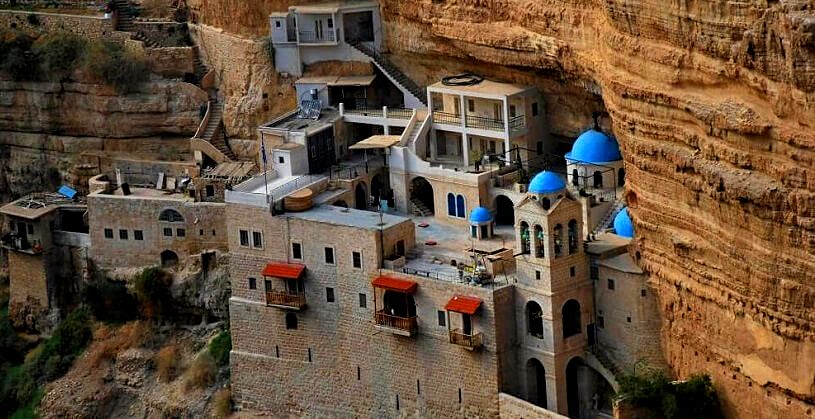
St. George's Monastery, Wadi Qelt. Photo credit: © Shutterstock
10. St. Joseph’s Church, Nazareth
St. Joseph’s Franciscan Сhurch is located in Nazareth, the town of Jesus’ birth, and was built, according to tradition, over what was once the carpentry workshop of Jesus’ father, Joseph. The site was converted into a place of worship in Byzantine times and after the Crusaders arrived, in 12 CE, another church was built over it. After the Crusaders were defeated by the Arabs, the church was destroyed and was not rebuilt until 1914, by the Franciscans.
Inside, the apse of the church has three paintings of interest: The Holy Family, The Dream of Joseph, and The Death of Joseph in the Arms of Jesus and Mary. Down a stairway lies a crypt where visitors can see caverns through a floor grille. A few more steps along leads to a black and white mosaic floor - some historians think that it was in use as early as the 1st-2nd century, and used as a pre-Constantine Christian Baptistery.
St. Joseph is situated north of the Basilica of the Annunciation and close to the large Franciscan convent Terra Santa. It can be visited easily, along with other places of interest in Nazareth, and perhaps combined with a visit to the nearby Sea of Galilee. A perfect fit would be the Nazareth and the Sea of Galilee Tour.
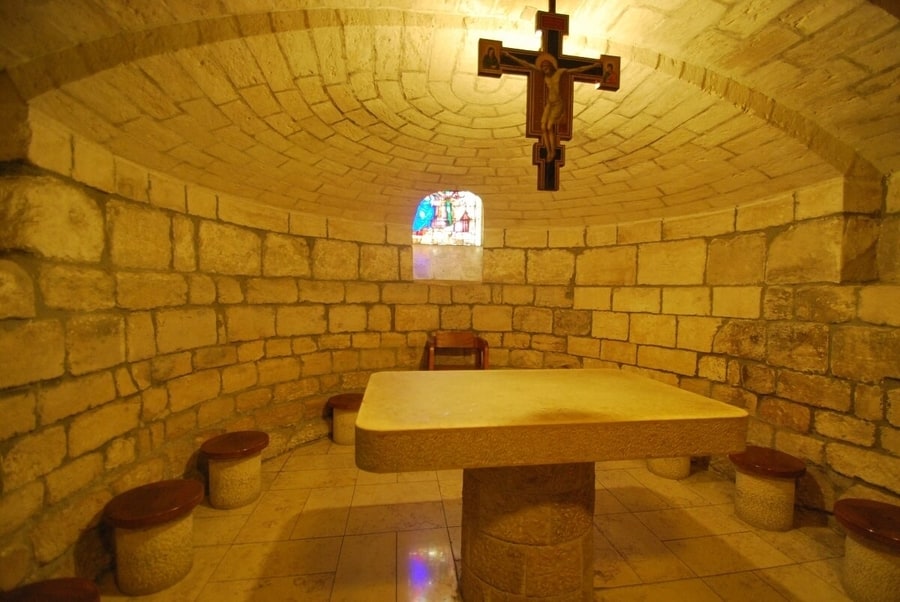
St. Joseph’s Church, Nazareth. Photo credit: © Shutterstock
 Login / Register
Login / Register
 Contact Us
Contact Us
 Certificate of Excellence
Certificate of Excellence Guaranteed Departure
Guaranteed Departure Low Prices Guaranteed
Low Prices Guaranteed 24/7 Support
24/7 Support




